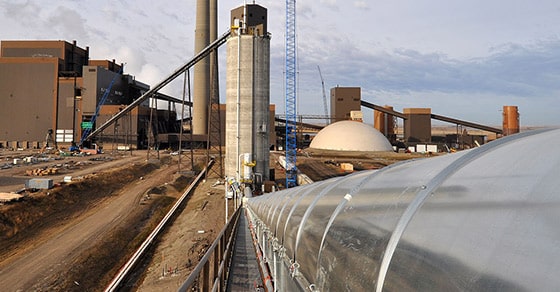Troughed belt conveyors are essential to industrial facilities in every industry, transporting material around plants, loading railcars and ships, conveying materials to storage, and so much more. Despite their ubiquity, however, a number of questions often arise during initial planning and design stages. What follows are the most frequently asked questions we receive around this bulk solids handling staple.
What is a troughed belt conveyor?
A troughed belt conveyor is a carrying surface that runs between two points to transport material from one location to another. Troughed belt conveyors are distinctly different from flat belt conveyors in that idlers, which support the belt, are angled to create a trough of material. This is ideal for handling bulk solids as it helps to keep material contained and minimize spillage.
Troughed belt conveyors can run either horizontally, or at a slight incline.
What is the maximum angle of incline a belt conveyor can run (how steep can a troughed belt conveyor be)?
Maximum angle of incline is dependent on the material to be conveyed, but a general rule of thumb is 20° maximum. With cleated belting, the angle may be increased to as high as 30°.
What is the max material temperature a conveyor belt can handle?
A standard conveyor belt is typically rated to handle material at temperatures up to 200°F. For applications where material temperature is higher, different types of heat-resistant belting can be employed, which can handle material up to 750°F.
What is the maximum length of a troughed belt conveyor?
A troughed belt conveyor is not limited in length. Any length can be accommodated, but lengths beyond several hundred feet (typically considered an “overland conveyor”) may require modifications to the design and various components to handle the extensive length. FEECO manufactures conveyors up to several hundred feet.
What is the maximum capacity of a troughed belt conveyor?
As with length, conveyor capacity is limited only by design and components. Typical troughed belt conveyors can be designed to handle upwards of 8,000 TPH depending on the belt width.
Capacity estimation charts are available in our Belt Conveyor Brochure.
How do I determine horsepower requirements for my conveyor?
Horsepower (HP) is calculated in three parts:
- The HP required to move an empty conveyor
- The HP required to move the specific material horizontally
- The HP required to move the specific material vertically
Basic estimations for horsepower can therefore be calculated using conveyor belt speed, length, rise, belt width, and capacity, though it’s important to note that factors such as drive efficiency and friction forces also come into play.
If the conveyor includes a belt tripper, additional horsepower will be required. For horsepower estimation tables, see our Belt Conveyor Brochure.
How can I prevent spillage?
While a new conveyor can be designed to minimize spillage, an existing conveyor may require some modifications. Depending on where and why spillage is occurring, there are many approaches to address it. This includes the addition of skirtboards, reduced idler spacing, an increase in trough depth, the incorporation of belt cleaners, and more. For more information on spillage, see our article: Mininmizing Spillage With Troughed Belt Conveyors.
Can I have more than one discharge point?
Yes, discharge points can be increased through the addition of a belt plow or tripper.
The incorporation of a belt plow, sometimes also called a discharge V-plow, allows material to be discharged on either or both sides of the belt at a fixed point along the conveyor.
A tripper, also known as a traveling tripper or tripper car, is more flexible, allowing material to be discharged at any point along the conveyor, either continuously, or at predetermined points, also on one or both sides.
For more information, see Belt Trippers Vs. Plows.
What are my options for protecting material from the elements?
Conveyors operating outdoors may require modifications to protect material from wind, snow, rain, and the like. In most cases weather covers are sufficient, but when protection is especially critical, conveyors can be provided with gallery enclosures.
What is the angle of a troughed conveyor idler?
Conveyor idlers can be positioned at angles of 20°, 35°, and 45°, depending on the required trough depth. A deeper trough allows the conveyor to carry a higher volume of material, but requires extra height and transition distance to flatten around pulleys. A shallower trough is typically used in applications where overall conveyor height must be kept to a minimum, such as when a fully skirted belt feeder is employed.
What belt options are available?
In addition to heat-resistant belting, conveyor belt manufacturers offer an array of belting types suited to different applications. This includes raised-profile/cleated belting for conveying at steeper angles, oil-resistant belting for protection from the risks of oily materials, and other options such as high-temperature, chemical resistant, solar resistant, abrasion/cut resistant, and fire resistant.
What is the best type of take-up for my conveyor?
The best type of take-up for a given application depends on the level of duty required, customer preference, the length of the conveyor, and any spatial limitations. For standard applications less than 150’ in length, FEECO recommends the screw take-up style. For applications greater than 150’ in length, FEECO recommends a gravity-style take-up.
How do I keep the belt clean?
Keeping a conveyor belt clean is essential to minimizing material spillage and reducing wear on equipment. Single or double belt cleaners (scrapers) are available, as are return-side belt plows (v-plows) and self-cleaning tail pulleys.
Conclusion
Troughed belt conveyors provide essential handling for bulk solids of all kinds. Despite their pervasive use, many questions can arise when selecting and designing a belt conveyor. FEECO recommends working with a bulk solids handling expert that can design an optimized conveyor system, along with any additional components to increase its flexibility and functionality.
FEECO has been manufacturing the industry’s best custom handling systems since 1951. For more information on our troughed belt conveyors, contact us today!



